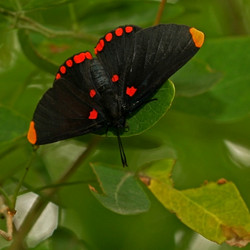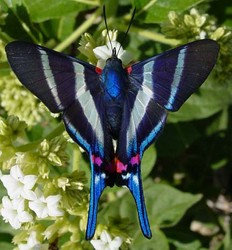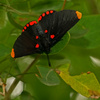Riodinidae
Metalmarks
Andrew V. Z. Brower


This tree diagram shows the relationships between several groups of organisms.
The root of the current tree connects the organisms featured in this tree to their containing group and the rest of the Tree of Life. The basal branching point in the tree represents the ancestor of the other groups in the tree. This ancestor diversified over time into several descendent subgroups, which are represented as internal nodes and terminal taxa to the right.

You can click on the root to travel down the Tree of Life all the way to the root of all Life, and you can click on the names of descendent subgroups to travel up the Tree of Life all the way to individual species.
For more information on ToL tree formatting, please see Interpreting the Tree or Classification. To learn more about phylogenetic trees, please visit our Phylogenetic Biology pages.
close boxIntroduction
Riodinidae are a pantropical family, with the majority of species occurring in the neotropics.Discussion of Phylogenetic Relationships
The tree shown is implied by classifications of Harvey (1987), Corbet et al. (1992), Campbell et al. (2000), Hall (2003) and Lamas (2004), and should be viewed as an informal hypothesis in need of corroboration.
Nomenclature
Although Erycinidae Swainson 1827 appears to be a senior name to Riodinidae Grote 1895, the type genus Erycina Fabricius 1807 is a junior homonym of Erycina Lamarck 1805 (a genus of bivalve mollusk). A family-group name cannot be based on a generic name that is a junior homonym (ICZN Article 39), so Swainson's Erycinidae is invalid. The Commission ruled (ICZN opinion 1073, 1977) that the family group name for this taxon should be Riodinidae Grote 1895 (1827), based on the replacement generic name Riodina that was selected by Westwood [1851], even though there are alternative family-group names with priority (e. g., Nemeobiinae Bates [1868]; Mesosemiini Bates 1859). (Bates employed Erycinidae as the family-group name for these subordinate taxa). This is one of the more confusing puzzles in butterfly nomenclature.
References
Ackery, P. R., R. de Jong, and R. I. Vane-Wright. 1999. The butterflies: Hedyloidea, Hesperioidea, and Papilionoidea. Pages 264-300 in: Lepidoptera: Moths and Butterflies. 1. Evolution, Systematics, and Biogeography. Handbook of Zoology Vol. IV, Part 35. N. P. Kristensen, ed. De Gruyter, Berlin and New York.
Bridges CA. 1988. Catalogue of family-group and genus-group names (Lepidoptera: Rhopalocera). Charles A. Bridges, Urbana, IL.
Campbell, D. L., Brower, A. V. Z. & Pierce, N. E. 2000. Molecular evolution of the wingless gene and its implications for the phylogenetic placement of the butterfly family Riodinidae (Lepidoptera: Papilionoidea). Mol. Biol. Evol. 17, 684-696.
Corbet AS, Pendlebury HM, and Eliot JN. 1992. The butterflies of the Malay Peninsula. Malayan Nature Society, Kuala Lumpur.
Devries, P. J. 1997. The Butterflies of Costa Rica and Their Natural History: Riodinidae. Princeton University Press, N. J.
Hall, J. P. W. 2003 Phylogenetic reassessment of the five forewing radial-veined tribes of Riodininae (Lepidoptera: Riodininae. The Royal Entomological Society 28, 23-37.
Harvey, D. J. 1987. The higher classification of the Riodinidae (Lepidoptera). vii + 215 + [1] pp. Ph. D . Thesis, University of Texas, Austin.
Lamas G ed. 2004. Atlas of Neotropical Lepidoptera. Checklist: Part 4A Hesperioidea - Papiionoidea. Gainesville: Scientific Publishers/Association of Tropical Lepidoptera.
Title Illustrations

| Location | Rio Grande, Texas, USA |
|---|---|
| Specimen Condition | Live Specimen |
| Source | Red Bordered Pixie |
| Source Collection | Flickr |
| Image Use |
 This media file is licensed under the Creative Commons Attribution-NonCommercial-NoDerivs License - Version 2.0. This media file is licensed under the Creative Commons Attribution-NonCommercial-NoDerivs License - Version 2.0.
|
| Copyright | © 2008 crookrw |
| Scientific Name | Calephelis virginiensis |
|---|---|
| Location | Okeechobee County, Florida, USA |
| Specimen Condition | Live Specimen |
| Source Collection | BugGuide.Net |
| Image Use |
 This media file is licensed under the Creative Commons Attribution-NonCommercial-NoDerivs License - Version 2.0. This media file is licensed under the Creative Commons Attribution-NonCommercial-NoDerivs License - Version 2.0.
|
| Copyright | © Jeff Hollenbeck |
| Scientific Name | Rhetus arcius |
|---|---|
| Location | El Naranjo, San Luis Potosi, Mexico |
| Specimen Condition | Live Specimen |
| Identified By | Gill Carter |
| Life Cycle Stage | adult |
| View | dorsal |
| Source | Arcius Swordtail |
| Source Collection | Neotropical Butterflies |
| Copyright | © 2003 Gill Carter |
About This Page
Andrew V. Z. Brower

Middle Tennessee State University, Murfreesboro, Tennessee, USA
Correspondence regarding this page should be directed to Andrew V. Z. Brower at
abrower@mtsu.edu
Page copyright © 2007 Andrew V. Z. Brower
 Page: Tree of Life
Riodinidae . Metalmarks.
Authored by
Andrew V. Z. Brower.
The TEXT of this page is licensed under the
Creative Commons Attribution License - Version 3.0. Note that images and other media
featured on this page are each governed by their own license, and they may or may not be available
for reuse. Click on an image or a media link to access the media data window, which provides the
relevant licensing information. For the general terms and conditions of ToL material reuse and
redistribution, please see the Tree of Life Copyright
Policies.
Page: Tree of Life
Riodinidae . Metalmarks.
Authored by
Andrew V. Z. Brower.
The TEXT of this page is licensed under the
Creative Commons Attribution License - Version 3.0. Note that images and other media
featured on this page are each governed by their own license, and they may or may not be available
for reuse. Click on an image or a media link to access the media data window, which provides the
relevant licensing information. For the general terms and conditions of ToL material reuse and
redistribution, please see the Tree of Life Copyright
Policies.
- Content changed 01 January 2008
Citing this page:
Brower, Andrew V. Z. 2008. Riodinidae . Metalmarks. Version 01 January 2008 (under construction). http://tolweb.org/Riodinidae/12174/2008.01.01 in The Tree of Life Web Project, http://tolweb.org/











 Go to quick links
Go to quick search
Go to navigation for this section of the ToL site
Go to detailed links for the ToL site
Go to quick links
Go to quick search
Go to navigation for this section of the ToL site
Go to detailed links for the ToL site